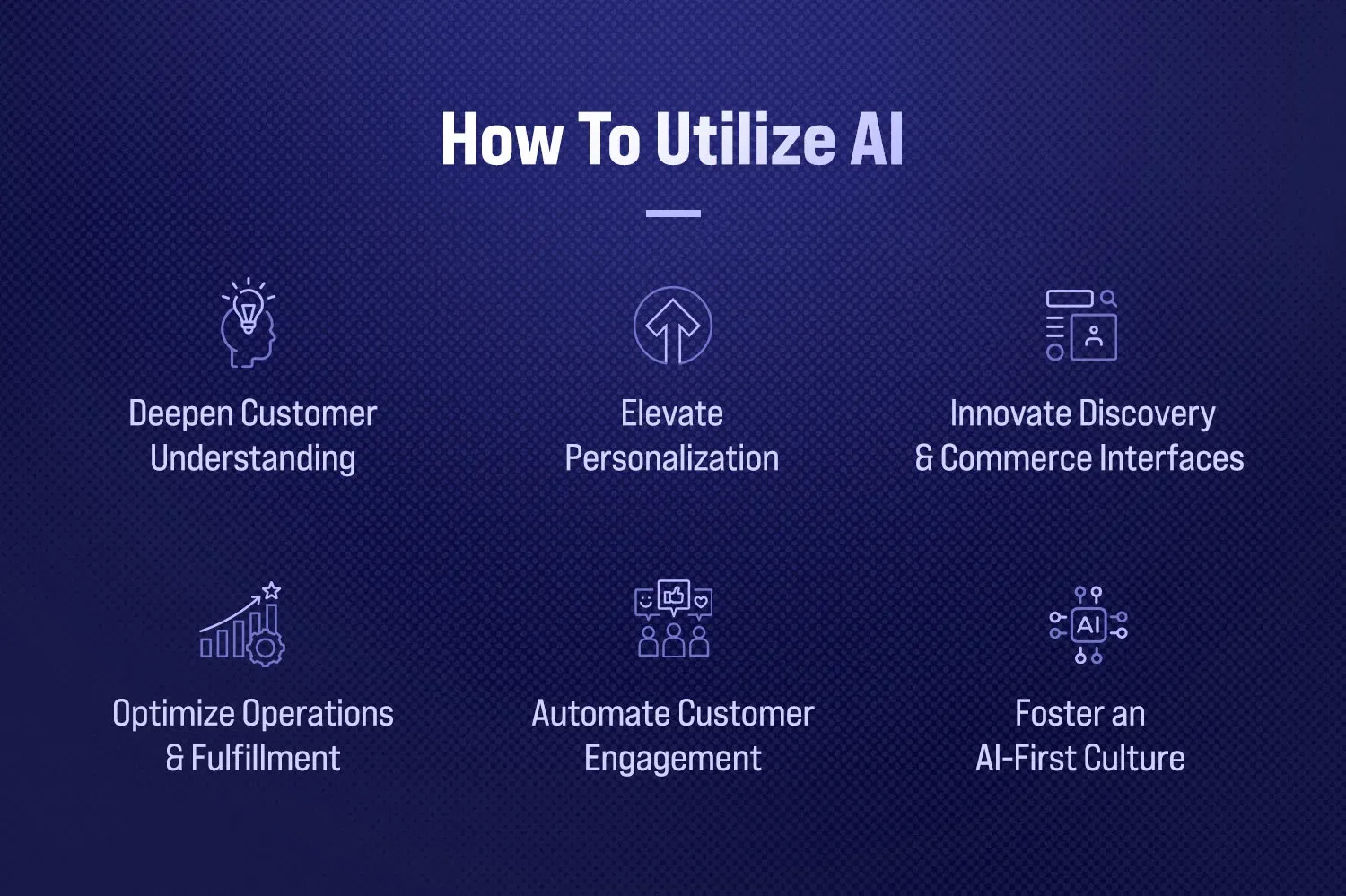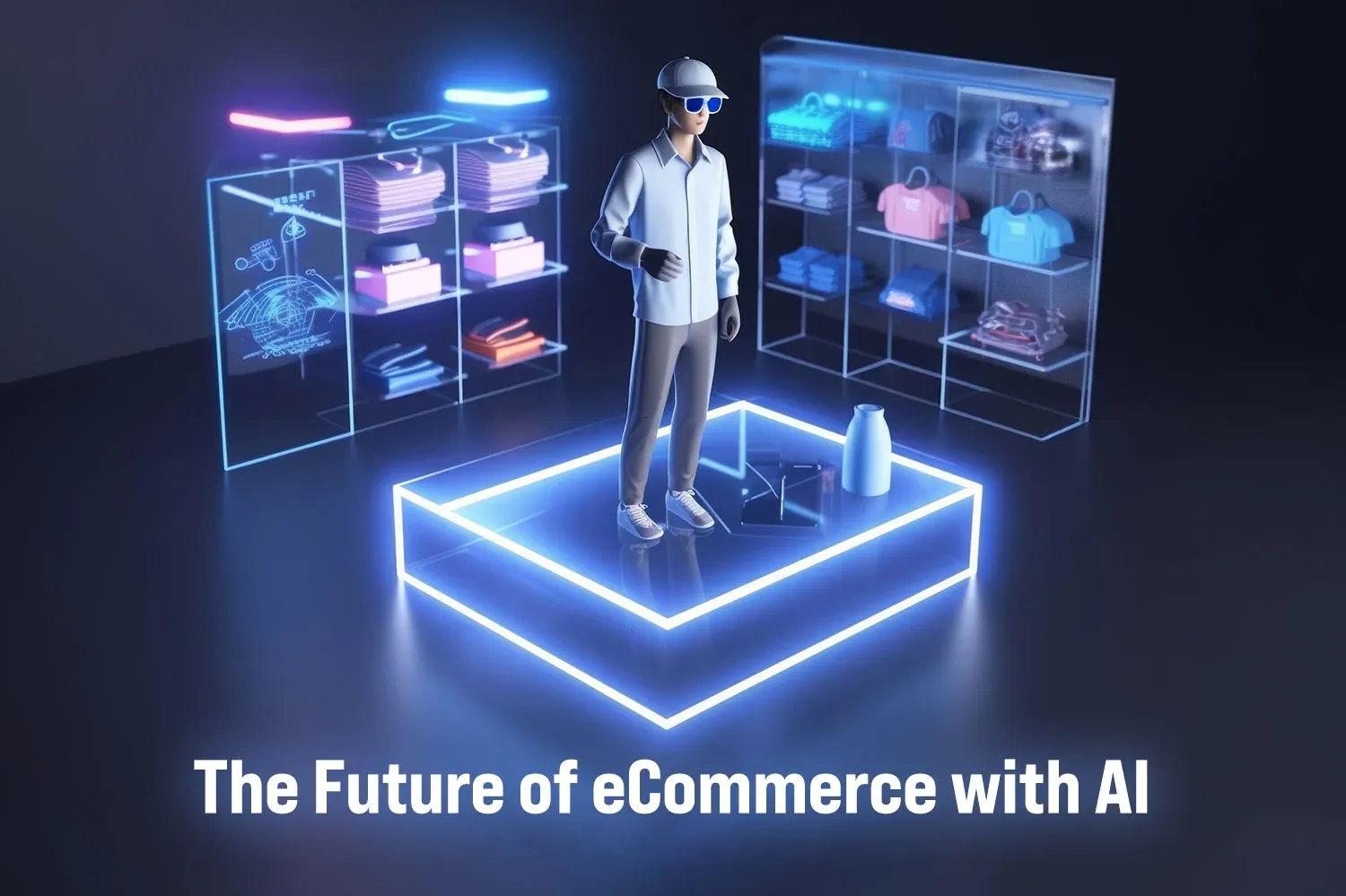AI in eCommerce

Artificial intelligence (AI) is transforming sectors worldwide, with its most profound impact seen in eCommerce. As companies embrace digital-first strategies, AI serves as a crucial tool for streamlining processes, improving customer engagement, and boosting revenue.
For management students, understanding the strategic implications of AI in eCommerce is essential—not just from a technological perspective but from a business and competitive strategy standpoint.
This article explores how AI is changing eCommerce, how businesses can use it to create better customer experiences and smarter sales processes, and what the future holds.
How Is AI Changing eCommerce?
Artificial intelligence is fundamentally reshaping eCommerce by enabling retailers to anticipate customer needs, streamline operations, and unlock new revenue streams. AI-driven personalization alone can boost sales by up to 40%, as reported by top adopters, which helps increase customer satisfaction, acquisition, and engagement by 5–10%.
AI also powers smarter search functions that understand intent and context, reducing bounce rates by delivering hyper-relevant results via keyword, voice commands, or visual inputs.
Behind the scenes, machine learning also optimizes inventory management and forecasting. Adopters see logistics cost reductions of 15%, 35% more accurate stock levels, and 65% better service rates. These systems pull from transactional, behavioral, and external data to predict demand for Black Friday spikes or one-off events, enabling faster, more reliable delivery options.
Finally, conversational AI chatbots and generative models handle roughly 70% of online inquiries, offering 24/7 support, personalized upsells, and real-time order updates, while freeing human teams to focus on strategic tasks. Looking ahead, “agentic AI” will autonomously execute and optimize marketing, search, and service functions, further transforming eCommerce into a proactively intelligent, customer-centric ecosystem.
How To Utilize AI
Harnessing AI effectively means embedding intelligence into every customer touchpoint and backend process. Below is a structured framework, rooted in real-world best practices, that businesses can apply to design or evaluate AI initiatives in an eCommerce setting.

Deepen Customer Understanding
Data Consolidation & Profiling
- Action: Integrate customer data from web analytics, CRM, mobile apps, in-store kiosks, and social channels into a unified customer data platform (CDP).
- Outcome: A comprehensive, unified profile of every customer allows for precise segmentation and tailored experiences.
Predictive Segmentation
- Action: Use machine-learning clustering algorithms (e.g., k-means, DBSCAN) on behavioral and demographic attributes to uncover high-value segments and micro-segments.
- Outcome: Targeted offers aligned with recency, frequency, and monetary (RFM) scores can lift conversion rates significantly.
Elevate Personalization
Recommendation Engine
- Action: Implement a blended strategy that merges collaborative filtering (identifying shopper similarities) with content-based filtering (analyzing item characteristics).
- Outcome: Up to 15-20% increase in average order value (AOV) as customers discover relevant cross-sells and upsells.
Omnichannel Consistency
- Action: Orchestrate AI-driven content and pricing across web, mobile app, email, SMS, social ads, and in-store displays via a centralized decision engine.
- Outcome: Customers experience the same “you know me” journey regardless of channel, improving retention rates.
Innovate Discovery & Commerce Interfaces
Smart Search & Visual Discovery
- Action: Enhance search with NLP (to interpret intent and synonyms) and computer-vision APIs (to match user-uploaded images with catalog items).
- Outcome: Shoppers find what they want faster, which helps reduce search abandonment.
Voice & Conversational Commerce
- Action: Build or integrate with voice-assistant skills (Alexa, Google Assistant) that let users browse, reorder, and track orders hands-free.
- Outcome: A seamless, friction-free alternative shopping channel projected to grow by 25% annually.
Optimize Operations & Fulfillment
Dynamic Pricing & Promotion
- Action: Leverage reinforcement learning or gradient-boosted trees to adjust prices by SKU, region, time, and customer segment, balancing margin and conversion.
- Outcome: 5–8% increase in gross margin without alienating price-sensitive buyers.
Smart Logistics & Demand Forecasting
- Action: Combine time-series forecasting (ARIMA, LSTM networks) with external data (weather, events, social sentiment) to predict demand and optimize inventory allocation across warehouses.
- Outcome: 30–35% reduction in stockouts and 20% lower holding costs.
Automate Customer Engagement
AI-Powered Chatbots & Virtual Agents
- Action: Implement NLP-driven chatbots able to handle tier-1 support (order status, returns, sizing advice) and smoothly escalate to humans when needed.
- Outcome: Heavy reduction in live-agent workload and improved first-response times.
Intelligent Remarketing
- Action: Trigger personalized email/SMS/push campaigns based on real-time behavior like abandoned carts, product view streaks, and price-drop alerts.
- Outcome: Recover 10–15% of otherwise lost revenue from abandoned carts.
Foster an AI-First Culture
- Cross-Functional Collaboration: Break down silos between IT, marketing, supply chain, and finance so AI projects align with strategic goals.
- Continuous Learning: Offer workshops on AI basics and hands-on hackathons to build internal capabilities.
- Ethical Frameworks: Establish governance for data privacy, bias mitigation, and transparent AI usage to maintain customer trust and regulatory compliance.
A More Efficient Sales Process
AI streamlines and enhances nearly every step of the eCommerce sales funnel. Here’s how it drives efficiency across key areas:
Pricing Optimization
AI-powered pricing engines continuously analyze market conditions like competitor prices, inventory levels, and customer demand to adjust your product prices in real time. Instead of setting static prices or relying on manual repricing, you get dynamic pricing that balances profitability with competitiveness. This means you can respond instantly to spikes in demand or to underperforming items, ensuring you capture value without alienating price-sensitive shoppers.
Smart Search
Traditional site search often fails to interpret customer intent, leading to frustrating “no results” pages. AI-driven search understands natural language (including misspellings and conversational queries), learns from individual browsing patterns, and even processes visual inputs (like photos). As a result, it guides shoppers quickly to the items they’re looking for—reducing frustration, shortening the path to purchase, and helping customers discover relevant products they might not have found otherwise.
Automation
Repetitive tasks—such as product tagging, order confirmations, email follow-ups, and segmentation—can overwhelm eCommerce teams as they scale. AI automates these routine workflows: it classifies new items into categories, triggers personalized emails based on customer behavior, and updates inventory records without human intervention. Automation frees up your staff to focus on strategic initiatives (like new marketing campaigns or supplier negotiations) while ensuring operational consistency and speed.
Smart Logistics
Behind every sale is a complex journey of picking, packing, and shipping. AI optimizes this process by determining which warehouse should fulfill an order based on location and stock levels, plotting the fastest delivery routes, and predicting potential delays (from weather or traffic). The result is fewer shipping errors, faster delivery times, and lower transportation costs—all of which contribute to a smoother customer experience and better margins.
Demand Forecasting
Seasonal promotions, product launches, and unexpected market shifts can wreak havoc on inventory planning. AI-driven demand prediction models analyze past sales records alongside external factors (like trending topics or market conditions) to generate sharper forecasts. This helps you stock the right quantities at the right locations, minimizes both overstock and stockouts, and keeps working capital lean—ensuring you can meet customer needs without waste.
Steps to Implement AI with eCommerce
Here’s a clear, ten-step guide grounded in real-world best practices to help your eCommerce business harness AI effectively and responsibly.
- Clarify Strategic Goals: Begin by pinpointing the exact problems or opportunities AI should address—whether it’s boosting conversion rates, slashing cart abandonment, or streamlining logistics. Tying each AI initiative to a specific business objective ensures you measure success by meaningful KPIs, not just technical benchmarks.
- Conduct a Data Health Check: AI thrives on quality data. Audit your existing customer, transaction, and operational datasets to identify gaps, inconsistencies, and privacy risks. Cleanse, de-duplicate, and standardize records, then centralize them in a secure data platform that supports scalable analytics.
- Assemble a Cross-Functional Task Force: Successful AI projects break down silos. Form a dedicated team combining marketing, IT, supply chain, and customer-service experts, alongside data scientists or external consultants. This blend of domain knowledge and technical skill ensures your solutions align with both customer needs and back-end realities.
- Prioritize High-Impact Use Cases: Rather than trying to tackle every conceivable AI application at once, focus first on a narrow set of “quick wins.” Examples include personalized product recommendations, smart search enhancements, or automated email remarketing. Early successes build momentum—and a stronger ROI justification—for broader rollouts.
- Evaluate and Select AI Tools: Decide whether to develop in-house models or leverage existing SaaS platforms and APIs. Off-the-shelf solutions (e.g., recommendation engines, chatbot frameworks, and demand-forecasting tools) can be deployed quickly, while custom models allow for deeper differentiation—albeit with higher development cost and complexity.
- Prototype with Minimum Viable Products (MVPs): For each prioritized use case, build a lightweight MVP that integrates a core AI capability into a live environment. For instance, embed a basic recommendation widget on a subset of product pages or launch a limited scope chatbot. This approach reduces risk and lets you collect real user feedback early.
- Pilot, Test, and Refine: Roll out your MVPs to a controlled user segment, then track performance metrics—such as click-through rates, conversion lifts, or support case deflection. Use A/B tests to compare AI-driven experiences against your existing setup and refine your algorithms and user flows based on empirical results.
- Integrate and Automate: Once a pilot proves its value, fully integrate the AI feature into your eCommerce platform, CRM, and marketing automation stack. Automate routine workflows—like sending personalized cart-abandonment emails or repricing items dynamically—so your teams can shift focus from manual tasks to strategic oversight.
- Monitor, Measure, and Iterate: AI models degrade if left unchecked. Establish continuous monitoring for accuracy, bias, and system health. Set up dashboards for real-time visibility of key metrics, and schedule regular retraining cycles to keep algorithms aligned with evolving customer behaviors and market conditions.
- Governance, Ethics & Culture: Embed strong data-governance policies to safeguard privacy and ensure compliance with regulations like GDPR. Create an “AI ethics” framework to address bias and transparency concerns. Finally, foster an organizational culture of experimentation—encourage cross-department upskilling and celebrate AI-driven wins to sustain innovation.
By integrating AI into these functions, eCommerce platforms can significantly enhance customer experience, reduce operational costs, and drive business growth.
The Future of eCommerce with AI
The future of AI in eCommerce is evolving from basic automation into a dynamic force that redefines how retailers engage with customers, manage operations, and stay ahead in a highly competitive digital marketplace. As AI tools grow more user-friendly and widespread, early adopters will gain a competitive edge.

Creating Truly Personalized Shopping Journeys
In the years ahead, personalization will evolve into hyper-personalization. AI systems will analyze a rich mix of customer data—ranging from browsing behavior to past purchases and even real-time interactions—to craft uniquely tailored experiences. Rather than simply recommending similar products, AI will deliver contextually relevant suggestions at every touchpoint: homepage displays, email campaigns, checkout flows, and even retargeting ads. Such hyper-targeted customization fosters deeper brand allegiance and drives higher purchase rates.
Smarter Search and Discovery
Traditional search functions are rapidly becoming outdated. The next generation of AI-powered search will interpret user intent rather than rely on exact keywords. This means customers will be able to search by style, mood, or visual cues rather than brand names or item types. For example, typing “comfy fall outfit” could return curated options across categories, thanks to AI’s ability to understand semantics and visual context. This refined approach to product recommendations minimizes shopping obstacles and enhances user contentment.
Virtual Assistants That Go Beyond Chat
Future AI chatbots will go beyond basic queries—evolving into savvy, personalized shopping guides. By using natural language processing (NLP) and learning from prior interactions, these virtual agents will offer conversational, human-like support. They’ll handle tasks such as recommending products, initiating returns, tracking shipments, and even resolving complex issues. This allows human support teams to dedicate their expertise to complex and critical customer issues.
Real-Time, Adaptive Pricing Models
AI-driven dynamic pricing is set to become a core strategy for online retailers. Leveraging real-time data on consumer demand, competitor activity, inventory levels, and even weather or regional events, AI can suggest or automatically adjust prices to maximize sales and profit margins. Unlike static pricing models, dynamic pricing ensures businesses stay agile and competitive without relying on manual market monitoring.
Intelligent Inventory and Supply Chain Optimization
AI’s predictive capabilities will revolutionize inventory planning. By identifying trends and forecasting demand with high accuracy, retailers can ensure they stock the right products at the right quantities—minimizing overstock and understock scenarios. This kind of smart planning supports sustainability efforts by reducing waste while also improving customer satisfaction through better availability.
Seamless and Speedy Fulfillment
The logistics arm of eCommerce will be more tightly integrated with AI as well. From warehouse automation that reduces picking errors to algorithms that optimize delivery routes in real-time, AI will make fulfillment faster, more efficient, and cost-effective. Customers will benefit from faster delivery times and improved order accuracy, both of which are critical in an age where expectations are sky-high.
FAQs
Q1. What is the role of AI in media and eCommerce?
Ans: AI is transforming media by automating content creation, personalizing content delivery, and enhancing user experiences. It powers recommendation engines (like on Netflix or YouTube), automates video editing, analyzes audience behavior, and even generates written or visual content using generative AI.
On the other hand, AI enhances eCommerce experience through personalized product recommendations, intelligent search, dynamic pricing, virtual assistants, and predictive analytics. It helps retailers understand customer behavior, optimize inventory, automate customer service, and streamline logistics.
Summing Up
AI is a force that’s fundamentally reshaping how eCommerce businesses operate and compete. From delivering deeply personalized shopping experiences to optimizing pricing, logistics, and customer engagement, AI empowers companies to be faster, smarter, and more customer centric.
For management students and future business leaders, understanding how to strategically deploy AI is critical—not just to leverage its technical capabilities, but to drive meaningful business value, customer loyalty, and long-term growth. As AI continues to evolve, those who embrace it early, responsibly, and with a clear vision will lead the next generation of digital commerce.

